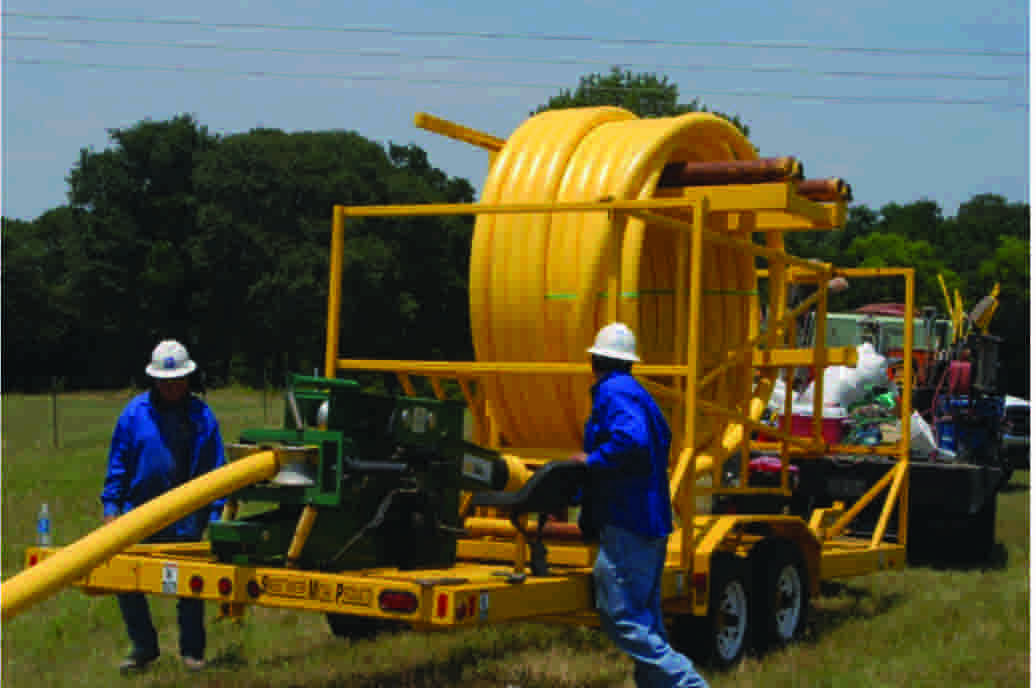December 2016, Vol. 243, No. 12
Features
Gathering, Fracking Create Greater Demand for Plastic Pipe

The plastics industry continues to push the envelope in creating higher performance materials for pipe, which then inspires new compositions and installation techniques. And the main benefactors are gas utilities, exploration and production companies, and ultimately their customers.
The research and development teams of pipe and resin manufacturers that are members of our association continually work to produce new products and develop multi-layer pipe structures required for demanding applications never seen before, especially for gathering, and the distribution of oil and natural gas.
In North America, there are over 3 billion feet of polyethylene pipe (PE) being used in gas distribution along with over 40 million PE gas services for residential and commercial applications.
While improved performance during the lifetime of the pipeline is critical, economic factors must be considered as well. For example, the cost for direct burial installations of pipe from 2-6 inches range from $4-32 a foot for PE, while similar sizes of protected steel pipe range from $12-75 a foot.
It has also been shown that 12-inch PE mains are cost-effective compared to steel and, as a result, are considered standard products. The American Gas Foundation report, Gas Distribution Infrastructure: Pipeline Replacement and Upgrades, indicates plastic pipe is the preferred material of the gas distribution pipeline industry. Chemical resistance, abrasion resistance and a fused joining system are just some of the reasons high-density polyethylene (HDPE) pipe is so widely accepted in this industry.
While HDPE and medium-density polyethylene (MDPE) are the most widely used pipe materials in distribution systems, the demand for pipeline replacement and the increase in demanding projects are accelerating the need for other polymers that can handle extreme heat and pressure, especially in the oil patch.
HDPE pipe was first used in gas gathering in 1957. Today, it is the largest market served by pressure-rated PE pipe. The durability and leak-free characteristics of the system make it the number one choice when pressures allow its use.
Hydro-fracturing uses HDPE pipe for not only the collection and transportation of hydrocarbons, but also for the transportation and collection of the water used in the process.
With the great acceptance of plastic pipe in the oil patch, engineers began looking for more opportunities to use it. Many of the applications, however, exceeded the pressure design limitations of conventional HDPE. As a result, a new category of plastic pipe has been developed to incorporate layers of HDPE along with metallic and non-metallic (glass and carbon fiber) substrates, creating a composite structure. Ranging from 2-8 inches, these pipes can handle pressures from 300-3,000 psi and in some of the most difficult terrains across the country
Polyamides (PA), commonly known as “nylons,” have been used in gas systems since the 1990s. PA11 and PA12 are the most common of these grades used for pipe. These bring the same corrosion-resistant and leak-free characteristics as PE pipe systems with a higher hydrostatic design basis (HDB), allowing use at higher pressures and temperatures.
New Challenges
Although plastic resins and structures continue to be improved and created, one key property still finds exceptional demand: flexibility. It has been documented many times that gas distribution systems are more apt to survive severe ground shifts, especially from earthquakes, when made from fused PE pipe. That flexibility also makes PE pipe the material of choice in the growing use of trenchless installation including horizontal directional drilling (HDD), pipe bursting and slip-lining. A 2016 survey showed HDPE has a 49.9% share of the North American HDD market.
Trenchless applications avoid the need for digging long, wide trenches, which is significantly more expensive, and would negatively impact residents by damaging existing pavement and landscaping, as well as causing traffic congestion from construction.
Recent developments for utilities include the commercialization of PE 4710 pipe, allowing for the maximization of pipe performance in gas systems, bringing an excellent level of environmental stress crack resistance and enabling a piping system to be operated at high pressure without sacrificing safety or service life. PE 4710 produces a highly efficient pipe, which leads to savings in materials, transportation and installation.
For over 60 years, the plastic pipe industry has continued to bring new and innovative materials, structures and installation techniques to the energy market. Higher performance and lower costs are the hallmarks in this ever-dynamic industry. And yet, it’s not just limited to pipe and installations. Industry support is also growing for improved tracking and traceability.
Progress in this area includes a tracking and traceability system that provides a standardized approach to marking all gas distribution system components including barcode markings. It was developed so manufacturers could easily provide product traceability information that gas utilities can use to implement distribution integrity management programs (DIMP), which are mandated by the Department of Transportation’s Pipeline and Hazardous Materials Safety Administration (PHMSA). The PPI has agreed to operate and maintain this registry at www.ComponentID.org.
Since 1950, the PPI has worked to make plastics the material of choice for pipe applications. Whether through research, education, testing, product development or industry advocacy, PPI members continue to search for more avenues to support the energy marketplace. For additional information, visit http://www.plasticpipe.org
Author: Tony Radoszewski is president of the Plastics Pipe Institute, Inc., the trade association representing all segments of the plastic pipe industry. He is a veteran of the plastics industry with 35 years of experience including leadership positions in sales, marketing and business development at Phillips 66 Company/Phillips Driscopipe. Radoszewski earned a bachelor’s degree in chemistry from St. Mary’s University in San Antonio, TX.





Comments